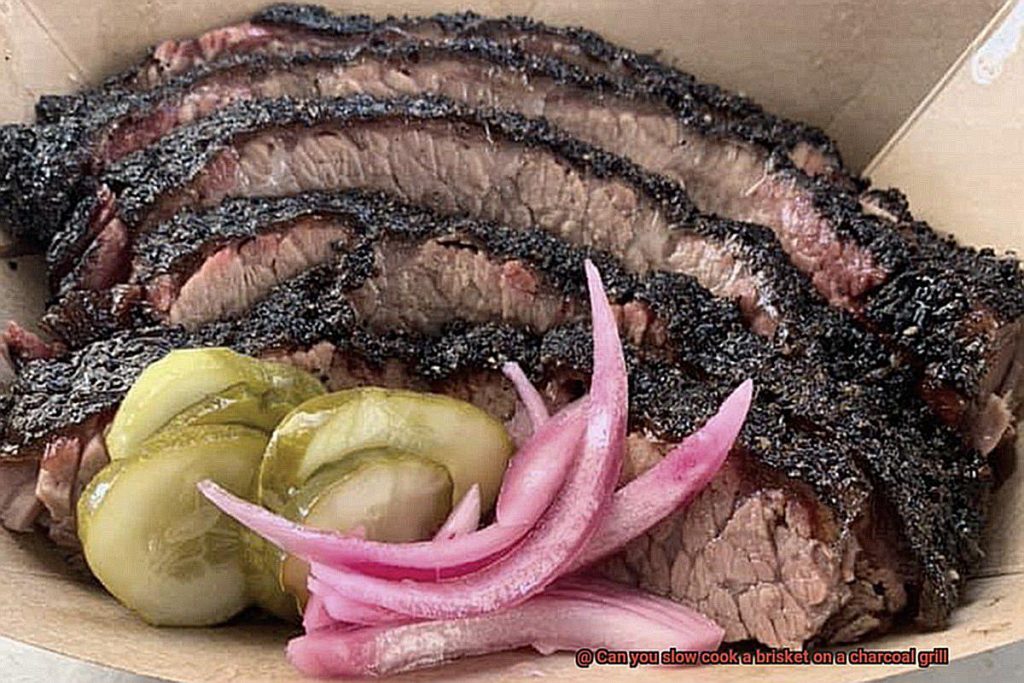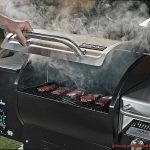Are you a barbecue enthusiast who prefers the smoky flavor of charcoal over electric or gas? If so, you might be wondering if it’s possible to slow cook a brisket on a charcoal grill. Well, the short answer is yes – but there are some things you need to know before diving into this endeavor.
First and foremost, smoking a brisket on a charcoal grill is not for the impatient. It’s a time-consuming process that requires maintaining a steady low temperature over several hours. Plus, mastering the technique and skills required for charcoal smoking can take some practice. And let’s not forget about the unique flavor profile that comes with cooking brisket on charcoal – it’s important to keep in mind when planning your meal.
But fear not. In this post, we’ll guide you through how to properly prepare and slow cook precisely seasoned brisket on your trusty charcoal grill. We’ll cover everything from the tools you need to the type of charcoal and wood for smoking, as well as tips for maintaining just the right temperature throughout the cooking process.
While it may seem intimidating at first, with our expert guidance and step-by-step instructions, you’ll be able to create mouth-watering brisket with an unbeatable smoky flavor that will impress your family and friends. So fire up that grill and get ready to become a master of slow-cooked brisket.
Contents
Choosing the Right Cut of Meat
If you’re in the mood for some juicy, smoky brisket, you’ll need to choose the right cut of meat. Brisket comes from the chest of the cow and is a tough cut that requires low and slow cooking to become tender and flavorful. Here are some tips to help you choose the perfect brisket for slow cooking on a charcoal grill.
Firstly, opt for a full packer brisket that includes both the flat and point muscles. The flat muscle is leaner with a tighter grain, while the point muscle has more marbling and fat. Choosing a full packer brisket gives you both textures and flavors for a mouth-watering end result.
Next, pay attention to the marbling. Marbling is the flecks of fat throughout the meat that melt during cooking, adding flavor and moisture to your brisket. Look for a brisket with good marbling throughout the meat to avoid dry and tough end products.
It’s also important to consider the grade of beef when choosing your cut of meat. USDA grades beef based on its marbling, age, and texture. A higher grade brisket will have more marbling and tenderness, but it may come with a higher price tag.
Once you have your perfect brisket, it’s time to prepare your grill for indirect heat cooking. Set up your coals on one side of the grill and place the brisket away from direct heat on the other side. Add wood chips or chunks to create smoke for an authentic barbecue flavor.
Don’t forget to season your brisket generously with a simple rub of salt and pepper or other spices and herbs for extra flavor. Maintain a consistent temperature between 225-250 degrees Fahrenheit throughout the cooking process using your grill’s air vents and adding more coals or wood chips as needed.
Preparing Your Grill for Indirect Heat Cooking
Indirect heat cooking is the secret to achieving that mouth-watering brisket you’ve been dreaming of. To prepare your grill for this cooking method, start by giving those grill grates a good cleaning. Using a grill brush, scrape off any debris from previous grilling sessions.
Next, you’ll need to get your charcoal going. Place it on one side of the grill and light it up. Once the coals are hot and ready, spread them out on one side of the grill using tongs. This creates a space for your drip pan, which is essential for indirect heat cooking.
Fill the drip pan with water and place it on the other side of the grill, directly under where you’ll be placing your brisket. The water in the drip pan will help regulate the temperature and keep your brisket moist throughout the cooking process.
Temperature control is key when it comes to slow-cooking a brisket. Use a thermometer to monitor the temperature of your grill, aiming for a range of 225-250°F. Adjust the vents accordingly to maintain a consistent temperature.
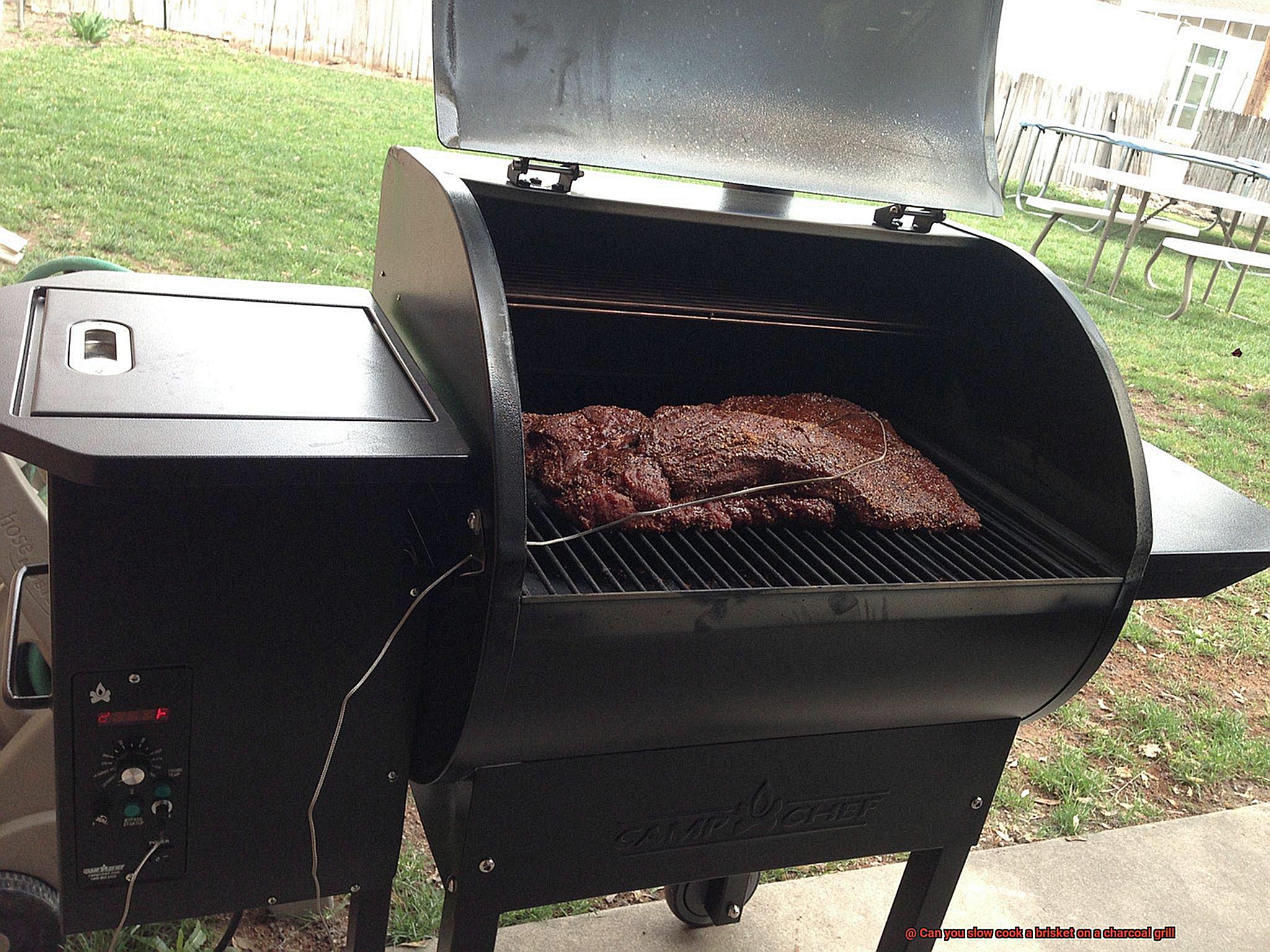
To recap, here are the steps to preparing your grill for indirect heat cooking:
- Clean your grill grates thoroughly.
- Place charcoal on one side of the grill and light it up.
- Spread out hot coals on one side of the grill using tongs.
- Place a drip pan filled with water on the other side of the grill under where you’ll be placing your brisket.
- Use a thermometer to monitor and maintain a consistent temperature.
Seasoning Your Brisket
Look no further than the seasoning step, where you can infuse your meat with a depth of flavor that will leave your guests speechless. As an expert in this subject, I’m here to share with you the different methods for seasoning a brisket before grilling on a charcoal grill.
First up, we have the dry rub method. This is where you get to mix and match your favorite herbs and spices to create a personalized blend that will complement the natural taste of the meat. Think salt, pepper, garlic powder, onion powder, paprika, and cumin, but don’t be afraid to get creative and try new combinations that suit your taste buds. Once you’ve mixed your rub, apply it liberally to all sides of the brisket, making sure to massage it into the meat for maximum flavor penetration. Let the brisket sit with the rub on for at least an hour before grilling, allowing time for the flavors to meld together.
If you prefer a wet marinade, there are plenty of options available. A popular choice is soy sauce, Worcestershire sauce, apple cider vinegar, and brown sugar, which can be mixed together in a bowl or plastic bag. Marinating the brisket in this mixture for at least 4 hours (preferably overnight) will allow the flavors to penetrate deep into the meat and tenderize it.
No matter which method you choose, it’s important to let the brisket come to room temperature before grilling. This will ensure that it cooks evenly and prevents any potential health risks associated with cooking cold meat on a hot grill.
Maintaining Consistent Temperature
The art of slow cooking a brisket on a charcoal grill is not for the faint of heart. It takes precision, patience, and attention to detail to achieve the perfect, mouth-watering result. One of the most critical factors in achieving this is maintaining a consistent temperature throughout the entire cooking process.
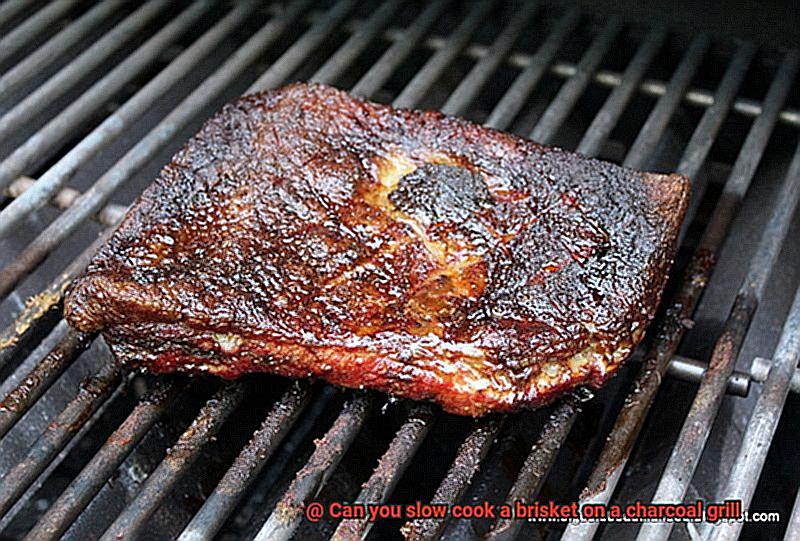
To start, your choice of charcoal is crucial. Many pitmasters prefer lump charcoal over briquettes because it burns hotter and longer, providing a more stable temperature. Additionally, adding wood chips to the charcoal can create smoke that infuses your meat with delicious flavor.
Once you have your charcoal set up, regulating airflow is essential to maintaining a steady temperature. Adjusting the vents on your grill allows you to control the amount of oxygen that feeds the flames and how much heat escapes. If the temperature is too high, partially or fully close the vents. Conversely, if it’s too low, open them up more.
A reliable thermometer is also a helpful tool in monitoring both the brisket and grill temperatures. This will help you make adjustments as needed and ensure that everything is cooking evenly. Remember, consistency is key.
Lastly, resist the urge to check on your meat too frequently. Every time you open the lid, heat escapes and can cause fluctuations in temperature which can prolong cooking time and affect the quality of your brisket. Trust in your equipment and let it do its job without constant interference.
Calculating the Cooking Time
Slow cooking a brisket on a charcoal grill is a fantastic way to impress your guests with your culinary skills. However, to achieve the perfect brisket, you must have a solid understanding of how to calculate the cooking time.
The “low and slow” method is a popular technique used to cook brisket on a charcoal grill. This method involves cooking the meat at a low temperature for an extended period of time using indirect heat. To calculate the cooking time for this method, you’ll need to consider the weight of the brisket and the desired internal temperature.
As a general rule of thumb, it’s recommended to cook your brisket for 1 hour per pound of meat at a temperature of 225-250 degrees Fahrenheit. For example, if you have a 10-pound brisket, it will take approximately 10 hours to cook using this method. However, keep in mind that various factors such as wind, humidity, and altitude can affect cooking times, so it’s crucial to monitor your brisket closely throughout the process.
To ensure that your brisket is cooked to perfection, use a reliable meat thermometer to check its internal temperature regularly. Insert the thermometer into the thickest part of the meat without touching any bones. The internal temperature of a fully cooked brisket should reach 185-205 degrees Fahrenheit.
Once you’ve reached your desired temperature, remove the brisket from the grill and let it rest for at least 30 minutes before slicing and serving. This resting period allows the juices to redistribute throughout the meat, resulting in a tender and juicy brisket.
Checking Internal Temperature with a Meat Thermometer
A mouth-watering, slow-cooked brisket is sure to impress your friends and family, but without the proper technique, it can easily go wrong. Fear not, as an expert in this field, I’m here to guide you through the process of checking the internal temperature with a meat thermometer for an unforgettable culinary experience.
Choosing the right meat thermometer is crucial. You can opt for digital or analog options, but ensure it’s calibrated correctly beforehand. Calibration can be done by following the manufacturer’s instructions or by testing it in boiling water. A few extra minutes spent on calibrating your thermometer can save you from a ruined brisket.
Once you have your thermometer ready, it’s time to check the internal temperature of your brisket. Insert the thermometer into the thickest part of the brisket, being mindful of avoiding any bone or fat. It’s essential to check the temperature in multiple areas to ensure that the entire brisket has reached the desired temperature.
For optimal tenderness of a slow-cooked brisket, aim for a temperature range of 195-205°F. However, don’t forget that different cuts of brisket may have slightly different temperature requirements. So, consulting a recipe or expert advice before starting is always a good idea.
After you’ve checked the internal temperature, allow your brisket to rest for at least 30 minutes before slicing. This step is often overlooked but incredibly important. Giving time for the juices to redistribute throughout the meat results in a more flavorful and tender final product.
Letting the Brisket Rest Before Slicing
Then don’t forget one essential step: let it rest before slicing. As an expert, I can attest that this step is crucial in achieving a tender and juicy final product that will leave your taste buds singing.
So, why should you let the brisket rest before slicing? Here’s what you need to know:
Even distribution of juices: Low and slow cooking pushes the juices inside the meat towards the center, resulting in uneven moisture distribution. Resting the brisket redistributes those juices throughout the meat evenly, resulting in a more succulent and flavorful brisket.
Stabilization of internal temperature: When you remove the brisket from the grill, residual heat causes its internal temperature to rise for several minutes. Allowing it to rest for at least 30 minutes stabilizes its temperature and prevents the juices from escaping when sliced into.
Tender slices: Slicing against the grain of the meat is crucial to tender slices. Letting the brisket rest relaxes its fibers, making it easier to slice against the grain. This means each slice will be tender, moist and easy to chew.
To let your brisket rest correctly, remove it from the heat source, wrap it in foil or butcher paper, and let it sit for at least 30 minutes. Wrapping helps retain its heat but can soften the bark; therefore, consider your preferences before deciding whether or not to wrap.
When ready to slice, use a sharp knife and cut against the grain of the meat for tender slices. Slice only what you need and keep the remaining brisket wrapped up until ready to serve.
Tips and Tricks for Slow Cooking a Brisket on a Charcoal Grill
Slow cooking a brisket on a charcoal grill may seem daunting, but it is a rewarding task that requires patience, time, and attention to detail. To achieve the perfect result, follow these tips and tricks:
Choose the Right Cut of Beef
A full packer brisket with plenty of marbling throughout both the flat and point muscles is ideal. This ensures that your meat stays moist and flavorful during the long cooking process. A leaner cut, such as the flat, may dry out more easily.
Prepare Your Grill for Indirect Heat
Slow-cooking a brisket requires low, indirect heat for several hours. Setting up your grill with a two-zone fire, with coals on one side and meat on the other, will allow you to regulate the temperature and prevent flare-ups. It is essential to maintain a steady temperature of around 225-250°F.
Use Wood Chunks for Flavor
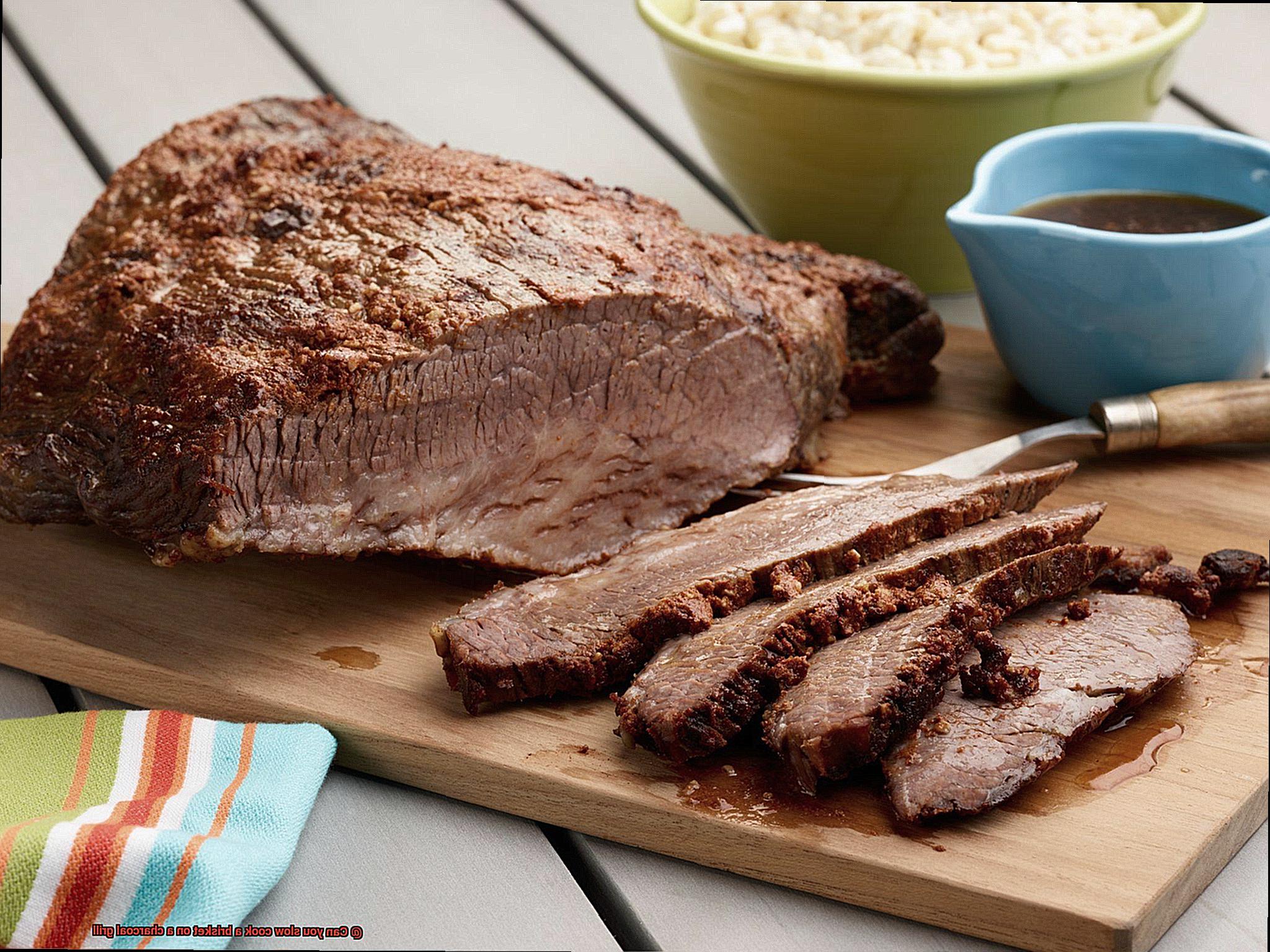
Adding wood chunks to your charcoal can give your brisket a delicious smoky flavor. Popular choices include hickory, oak, and mesquite. However, it is crucial not to overdo it as too much smoke can overpower the meat.
Season Your Brisket Generously
A good rub or marinade can enhance the flavor of your brisket. Apply your seasoning at least an hour before cooking and let it sit in the refrigerator to penetrate the meat thoroughly. Experiment with different spices and herbs to find a flavor profile you love.
Monitor the Temperature
Use a meat thermometer to monitor the internal temperature of your brisket throughout the cooking process. It should be cooked to at least 190-200°F for optimal tenderness. Be patient as this process can take several hours.
Wrap Your Brisket
Wrapping your brisket in foil or butcher paper halfway through cooking can help keep it moist and tender. This technique is known as the Texas Crutch and can be a game-changer for achieving the perfect brisket. However, be mindful that this can also affect the texture of the bark.
Let it Rest
Once your brisket is done cooking, let it rest for at least 30 minutes before slicing. This will allow the juices to redistribute throughout the meat and prevent it from drying out. Resist the urge to cut into it immediately, as this can cause the juices to escape.
7r9UunAsETg” >
Conclusion
In conclusion, slow-cooking a brisket on a charcoal grill is not only feasible but also an impressive culinary feat that your taste buds will thank you for. However, it requires patience, attention to detail, and the right technique to achieve perfection. From selecting the ideal cut of meat to seasoning it generously and monitoring the temperature throughout the cooking process, every step counts.
To ensure consistent temperature and flavor, choosing the right charcoal and regulating airflow by adjusting vents on your grill are crucial. Adding wood chunks can elevate your brisket’s smoky flavor to a whole new level, making it irresistible.
Remember that mastering the art of slow-cooking a brisket on a charcoal grill takes time and practice. Don’t be afraid to experiment with different spices and herbs until you find your perfect flavor profile. With our expert guidance and step-by-step instructions, you’ll be able to create mouth-watering brisket with an unbeatable smoky flavor that will leave everyone at your next barbecue party craving more.

